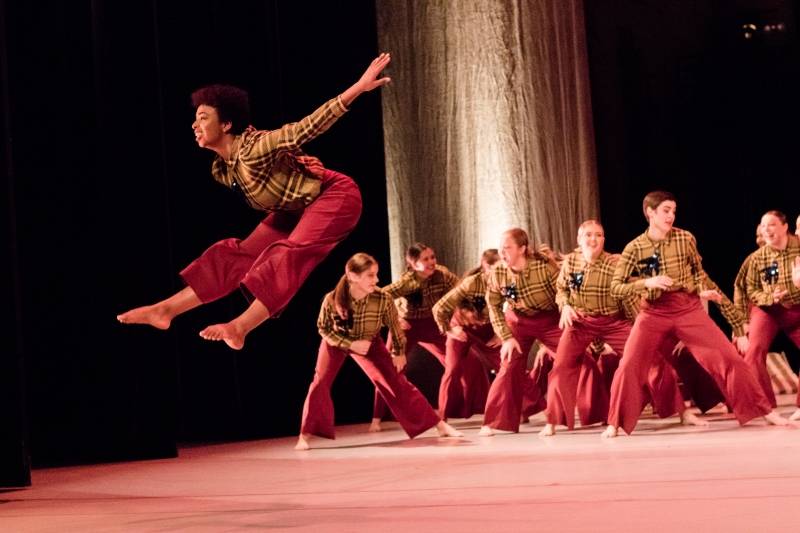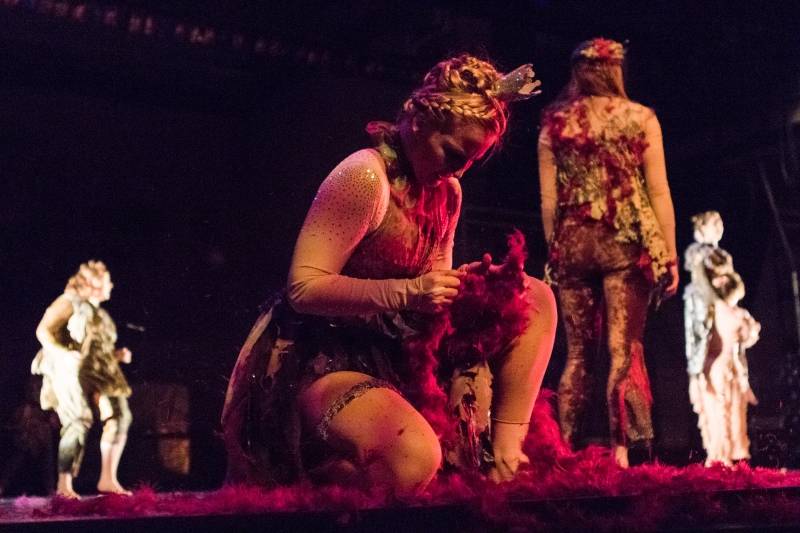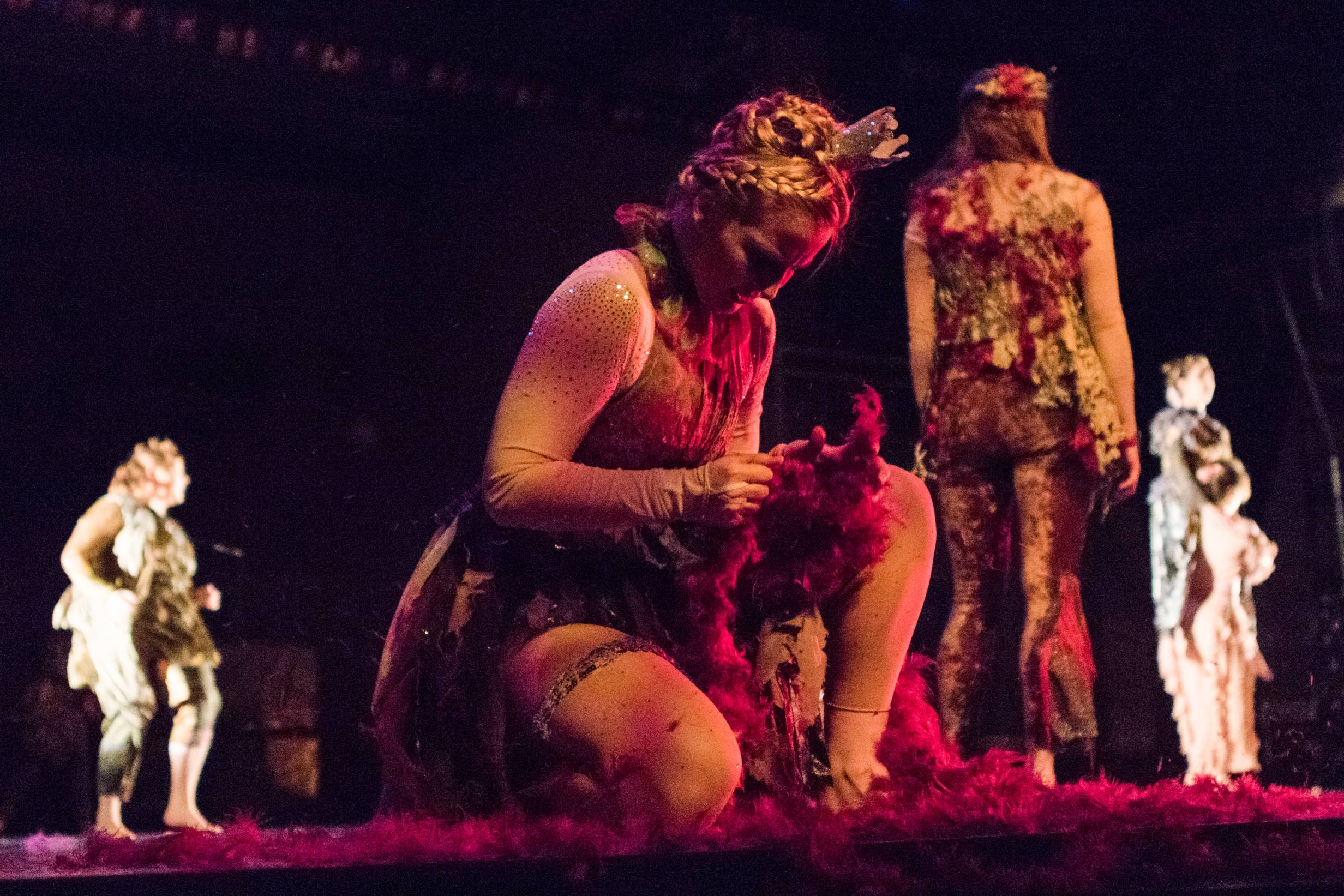As a second semester senior, I’m almost ashamed to admit that the 2018 production of February Dance at Krannert Center’s Colwell Playhouse was the first performance by the Illinois Dance Department I’ve ever been to. But after watching the performance, I realized that I also couldn’t have chosen a better introduction to Dance at Illinois and the incredible dancers that made up the energy, talent and spirit of the show itself.
Composed of five different pieces from a range of choreographers, each piece in February Dance looked at various events from over the past few years and tried to answer not just the question of why, but also what is the strongest way for American society as a whole to keep moving forward.
Danced with what professor and concert director Sara Hook explained as “a restless need to move energetically—perhaps in defiance, sometimes in pure joy [and] sometimes in remembrance,” February Dance had a gift for everyone in the audience. And if nothing else, I think it certainly made many of us want to dance—not walk—out of the theater after the final bow.
MOUNTAIN DEW HONEY SPRING
Choreographed by Grace Courvoisier, this piece was described in the playbill as taking “an ironic look at the female perspective of love and romance.” While I enjoyed the dancers energy and thought the performance itself was engaging by the use of various props and on stage singing, I also felt like whatever irony the choreographer was trying to portray was so ironic that it went right over my head.
Wearing the exact same costumes of red high waisted pants and flannel shirts, the dancers began the piece by simply walking on stage without any fanfare, lowering of the lights or audio introduction. From there, the audience was led through what I would describe as either the stages of falling in love and all its imperfections, or the process of growing up and trying to navigate the ups and downs of romantic relationships.
As this process most likely always has a hint of irony, I appreciated the choreographer’s take on this subject by including dancing that was not always pretty. Often there were moments where a dancer’s movements were clearly frustrated or even angry, and would take some time with the support of other dancers to come back to center.
Overall, I enjoyed the performance, and thought the incorporation of music ranging from Radiohead to Claude Debussy to The Sound of Music was fun and kept the audience on their toes. However, it was difficult to connect each music change and the new section that followed it as an entire whole. Subsequently, the piece seemed more like separate sections combined into one entire performance, which often broke the flow of the dance and made it harder to connect the dancers to Courvoisier’s intended message. Despite those drawbacks, Mountain Dew Honey Spring certainly put me in the mindset to be ready for a civically engaged show, which C. Kemal Nance’s piece Terminal C beautifully provided.

TERMINAL C
Before this piece even began, I knew the audience and I were in for a performance that was not going to let any of us sit comfortably. Beginning in a similar fashion to Mountain Dew Honey Spring, Terminal C opened with dancers walking down each aisle and onto the “terminal.” What begins as a typical day, with characters such as an Army soldier, a bachelorette party, businessman and a woman wearing a hijab all navigating the normal hassles of traveling, quickly turns into fear, confusion and potential ostracization as TV’s play President Trump’s travel ban announcement
Mirroring what thousands of people felt in the wake of the travel ban, Nance brought it to life by the abrupt cutoff of Funkadelic’s “One Nation Under a Groove” that changed the dancers from enthusiastic and connected to divided and painfully unsure.
As the one dancer representing a Muslim woman looks around at the other travelers, beseeching them not to literally and figuratively turn their backs on her, the remainder of the piece pointedly asked each audience member how they would respond if they suddenly found themselves in the equivalent of Terminal C.
Showcasing incredible dancers who deserved every single round of applause, Terminal C worked its way through the fear and unrest much of the country felt after the travel ban announcement. But despite the impact the ban continues to have today, Nance refused to let division have the final say. The choreography brought each dancer and the audience back together as the piece closed with joy, a renewed belief in the potential for unity and the demand to treat all peoples with respect and dignity. Ending with Louis Vega’s song “A New Day,” playing while the audience was surrounded by dancers in the outside aisles, Terminal C gave voice through dance to those affected and asked all of us to keep dancing, singing and moving with them.
(MY)TOM
Alright all Tom Petty fans, this piece was especially made for you. (Full disclosure: before this performance I had never listened to Tom Petty. Happily, this dance convinced me to do otherwise).
Choreographed by Linda Lehovec, this piece was one of the most heartfelt tributes I’d ever seen created for an artist. Playing two of Tom Petty’s songs “Melinda” and “Alright for Now,” the entire dance was an expression of not just remembrance for Tom Petty’s music, but also showcased what I imagine Tom Petty was also known for: a love of positivity, support for those around him and an unfailing ability to make his listener’s smile. Every single one of those attributes shown through Lehovec and the dancer’s choreography, and as an audience member was infectious and made the broad smiles on people’s faces that much more meaningful.
What I enjoyed most about the performance was that it, ironically, didn’t always feel like a formal performance. While on stage, the dancers audibly cheered for one another, and brought such intense enjoyment to their own art that I imagine it made many of us want to go and join them. This night was my first introduction to Tom Petty’s music, and while I left inspired to listen to a few soundtracks, (MY)Tom made me feel like I knew it already.

IN FULLNESS THEREOF
In keeping with the politically and socially engaged theme of the evening, In Fullness Thereof was as emotionally charged as Terminal C but in a poignantly haunting way. Described by choreographer Endalyn Taylor as “loosely based on the protesters of the Charlottesville Rally,” In Fullness Thereof took a step back from the shouting, anger and blame that usually follows a crisis to instead focus on the love, generosity and protection that is also overwhelmingly shown.
Danced entirely to “Says” by Nils Frahm, an instrumental piece that seemed to imply the inevitable questions we all ask ourselves following a man-made tragedy, In Fullness Thereof was not acting as judge and jury of what happened in Charlottesville, but instead urged all of us to live Winston Churchill’s quote to “Be kind, but be fierce.”
The dancers beautifully conveyed a sense of cohesive movement even when only two or three people were dancing, and the sole dancer dressed in all white appeared to honor Heather Heyer, the one woman who died during Charlottesville’s horrific attack. The piece’s pulsing energy, given through the music and the constant flow between each dancer, both pushed the dance and the audience forward while its inherent stillness asked that no one be forgotten.
As the curtain dropped between this piece and the final act Vestigial, I felt like Taylor and the dancers left us with much more than a beautiful dance. In Fullness Thereof lent peace but also a sense of loose ends that still need to be addressed in America. My hope is that we can face them with the same type of gentle intensity each dancer gave during this piece.
VESTIGIAL
A wonderfully creative piece sporting everything from endless confetti to singing to hysterical laughter to bombastic costumes, Vestigial was unfortunately the piece I enjoyed the least throughout the show. Choreographed by Leah Wilks, this piece, while danced with impressive commitment and direct eye contact with the audience, personally had the least amount of emotional engagement.
Inviting the audience to consider “What is our legacy? What do we leave behind in this world?”, the piece seemed too far rooted in theory to make physical connection with the audience. As the lights came up, I was more considering what the piece meant to me than what I hoped to leave behind in the world, and by the time I left puzzlement was still the dominating conclusion.
One thing I love, however, about contemporary dance is that having an “answer” or “official meaning” to a piece is superfluous. Whatever it meant to every person in the audience and on stage is all that mattered. So while Vestigial did not resonate with me, by the reactions of those around me and the look of accomplishment on the dancer’s faces, I knew how much Vestigial, and the entire evening, meant to them.
February Dance was at the Krannert Center February 1-3rd. To check out upcoming performances from Dance at Illinois, click here.
Photos by Natalie Fiol.








